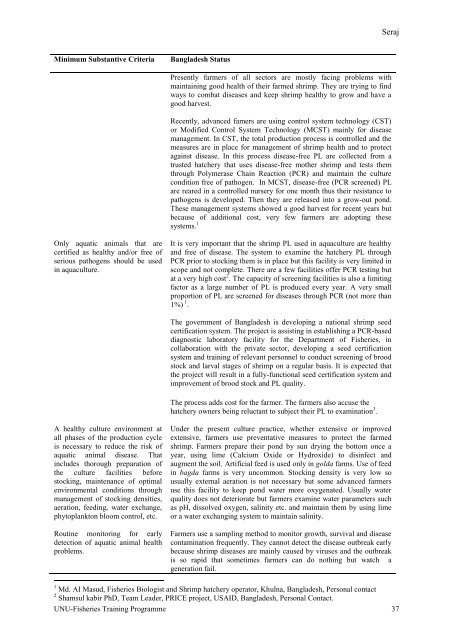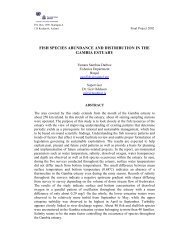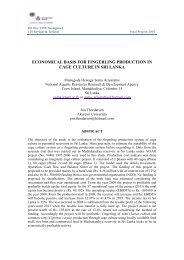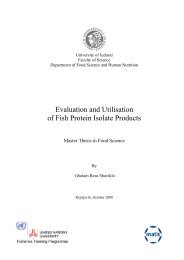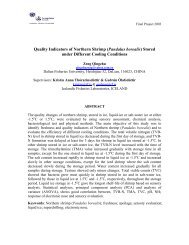a compliance study of Bangladesh shrimp aquaculture - The United ...
a compliance study of Bangladesh shrimp aquaculture - The United ...
a compliance study of Bangladesh shrimp aquaculture - The United ...
Create successful ePaper yourself
Turn your PDF publications into a flip-book with our unique Google optimized e-Paper software.
SerajMinimum Substantive Criteria<strong>Bangladesh</strong> StatusPresently farmers <strong>of</strong> all sectors are mostly facing problems withmaintaining good health <strong>of</strong> their farmed <strong>shrimp</strong>. <strong>The</strong>y are trying to findways to combat diseases and keep <strong>shrimp</strong> healthy to grow and have agood harvest.Recently, advanced famers are using control system technology (CST)or Modified Control System Technology (MCST) mainly for diseasemanagement. In CST, the total production process is controlled and themeasures are in place for management <strong>of</strong> <strong>shrimp</strong> health and to protectagainst disease. In this process disease-free PL are collected from atrusted hatchery that uses disease-free mother <strong>shrimp</strong> and tests themthrough Polymerase Chain Reaction (PCR) and maintain the culturecondition free <strong>of</strong> pathogen. In MCST, disease-free (PCR screened) PLare reared in a controlled nursery for one month thus their resistance topathogens is developed. <strong>The</strong>n they are released into a grow-out pond.<strong>The</strong>se management systems showed a good harvest for recent years butbecause <strong>of</strong> additional cost, very few farmers are adopting thesesystems. 1Only aquatic animals that arecertified as healthy and/or free <strong>of</strong>serious pathogens should be usedin <strong>aquaculture</strong>.It is very important that the <strong>shrimp</strong> PL used in <strong>aquaculture</strong> are healthyand free <strong>of</strong> disease. <strong>The</strong> system to examine the hatchery PL throughPCR prior to stocking them is in place but this facility is very limited inscope and not complete. <strong>The</strong>re are a few facilities <strong>of</strong>fer PCR testing butat a very high cost 2 . <strong>The</strong> capacity <strong>of</strong> screening facilities is also a limitingfactor as a large number <strong>of</strong> PL is produced every year. A very smallproportion <strong>of</strong> PL are screened for diseases through PCR (not more than1%) 1 .<strong>The</strong> government <strong>of</strong> <strong>Bangladesh</strong> is developing a national <strong>shrimp</strong> seedcertification system. <strong>The</strong> project is assisting in establishing a PCR-baseddiagnostic laboratory facility for the Department <strong>of</strong> Fisheries, incollaboration with the private sector, developing a seed certificationsystem and training <strong>of</strong> relevant personnel to conduct screening <strong>of</strong> broodstock and larval stages <strong>of</strong> <strong>shrimp</strong> on a regular basis. It is expected thatthe project will result in a fully-functional seed certification system andimprovement <strong>of</strong> brood stock and PL quality.<strong>The</strong> process adds cost for the farmer. <strong>The</strong> farmers also accuse thehatchery owners being reluctant to subject their PL to examination 3 .A healthy culture environment atall phases <strong>of</strong> the production cycleis necessary to reduce the risk <strong>of</strong>aquatic animal disease. Thatincludes thorough preparation <strong>of</strong>the culture facilities beforestocking, maintenance <strong>of</strong> optimalenvironmental conditions throughmanagement <strong>of</strong> stocking densities,aeration, feeding, water exchange,phytoplankton bloom control, etc.Routine monitoring for earlydetection <strong>of</strong> aquatic animal healthproblems.Under the present culture practice, whether extensive or improvedextensive, farmers use preventative measures to protect the farmed<strong>shrimp</strong>. Farmers prepare their pond by sun drying the bottom once ayear, using lime (Calcium Oxide or Hydroxide) to disinfect andaugment the soil. Artificial feed is used only in golda farms. Use <strong>of</strong> feedin bagda farms is very uncommon. Stocking density is very low sousually external aeration is not necessary but some advanced farmersuse this facility to keep pond water more oxygenated. Usually waterquality does not deteriorate but farmers examine water parameters suchas pH, dissolved oxygen, salinity etc. and maintain them by using limeor a water exchanging system to maintain salinity.Farmers use a sampling method to monitor growth, survival and diseasecontamination frequently. <strong>The</strong>y cannot detect the disease outbreak earlybecause <strong>shrimp</strong> diseases are mainly caused by viruses and the outbreakis so rapid that sometimes farmers can do nothing but watch ageneration fail.1 Md. AI Masud, Fisheries Biologist and Shrimp hatchery operator, Khulna, <strong>Bangladesh</strong>, Personal contact2 Shamsul kabir PhD, Team Leader, PRICE project, USAID, <strong>Bangladesh</strong>, Personal Contact.UNU-Fisheries Training Programme 37


